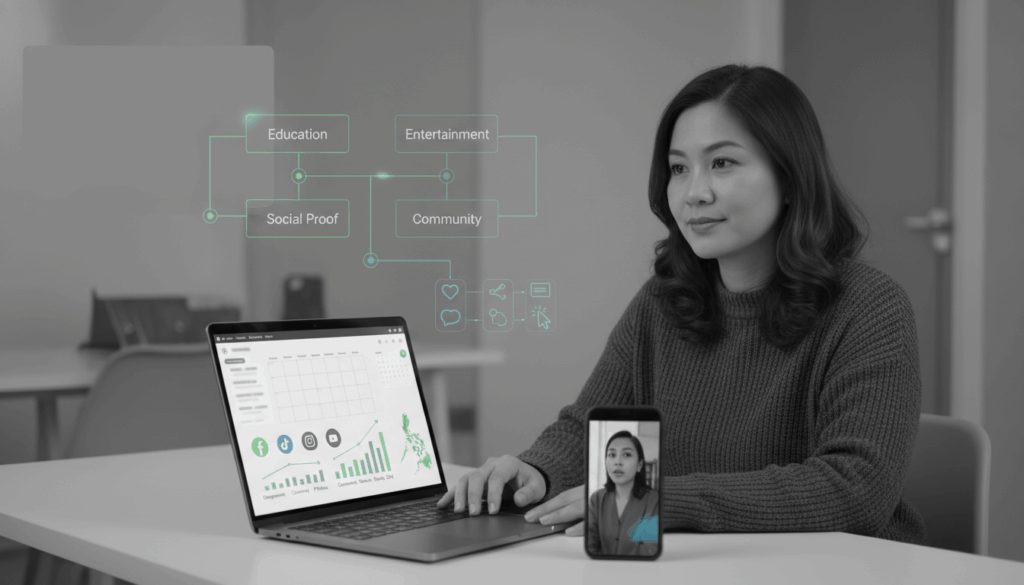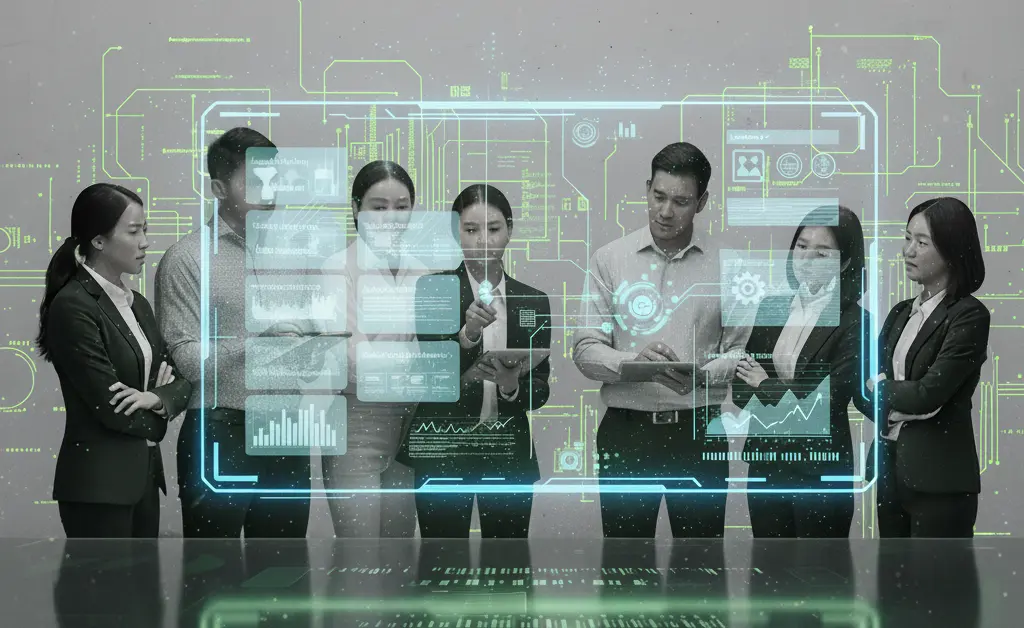
Let’s be honest—everyone’s talking about AI. But few businesses in the Philippines are truly AI-First.
Most are AI-enabled—they’re using chatbots, automated reports, or ad optimizations. Helpful, yes. But being AI-first means something bigger. It’s when AI becomes the engine that drives your entire marketing strategy—how you plan, decide, and operate.
Digital marketing is shifting faster than ever—and if you’re only “using AI here and there,” you may already be falling behind. The true frontier isn’t being AI-enabled or AI-Driven; it’s being AI-first.
In this post, we’ll dig into:
Table of Contents
Let’s dive in.
What’s the difference between being AI-enabled vs AI-first?
We often hear both these terms used interchangeably. But they’re very different strategically—and the distinction matters deeply when it comes to impact and longevity.
- AI-Enabled means you have tools that augment parts of your existing workflows with AI. For example: a chatbot, automated ad bidding, content suggestions. These are helpful, but AI is still “bolted on” to what you already do.
- AI is an add-on
- The core business operates without it
- Gains come incrementally
- Lower risk
- AI-First means your processes, strategies, and decision-making are built around AI as a core engine—not as an afterthought. AI is deeply integrated into how you operate.
- AI is foundational
- The business revolves around it
- Potential for exponential gains
- Higher risk, but higher reward
Multiple sources distinguish these terms. One analysis puts it this way:
AI-enabled solutions improve what already exists; AI-first companies rethink what’s possible.
For the Philippines, where digital adoption is accelerating and competition is fierce, being AI-first can be your long-term competitive edge.
How Leaders Can Move from Task-Level to System-Level AI
Deploying AI in individual tasks is a start—but if you want to lead in this space, you must think bigger: systems, culture, architecture.
a. Shift Mindset: From Tools to Systems
Don’t just ask, “Which tool can automate this task?” Instead ask, “How can AI transform this system end-to-end?” For example, instead of automating just email campaigns, imagine a system that adapts messaging in real time as prospects behave differently.
b. Build a Cross-Functional AI Team
You’ll need data engineers, machine learning specialists, AI operations (MLOps), and marketing experts all working together—not siloed.
Philippine agencies must start collaborating more across roles: analytics, creative, strategy—centered around AI pipelines.
c. Invest in Data Infrastructure & Quality
AI-first demands clean, unified, real-time data. Garbage in, garbage out. Systems must ingest, process, and analyze data seamlessly across channels (website, CRM, ads, social, etc.).
d. Promote AI Literacy & Trust
Most marketing teams today lack deep AI fluency. Tools won’t be enough—you need training, shared experiments, transparency in model decisions, and incentives for adoption.
A recent article highlighted that many teams buy AI tools but fail to extract value due to lack of proper training and confidence in using them.
Lifewire
e. Iterate & Learn Fast
An AI-first approach treats everything as an experiment: campaigns, models, audiences. Set up loops of fast testing, feedback, and refinement—not “set and forget.”
What Changes When Marketing Becomes AI-First
Switching from AI-enabled to AI-first isn’t just incremental—it changes how you operate at your core.
a. Strategy Becomes Predictive
Instead of planning campaigns based on past data, AI-first marketing forecasts future behavior (churn, purchases, content preferences) and acts in real time.
b. Personalization at Scale
When AI is baked in, every individual can get dynamic, personalized experiences—without manually creating dozens of variants. The system adapts to each user’s preferences and context.
c. Budget & Resources Shift
Thinking becomes: which campaigns to run, which models to retrain, which data to enrich, rather than micro-managing every ad bidding variable.
d. Creativity + AI Fusion
Creative ideas now co-evolve with model feedback. You don’t wait for campaign results—you co-create ads, messaging, and visuals with generative models.
e. Decisions Are Data-Driven, Not Gut-Driven
Human intuition still plays a role—but in an AI-first setup, decisions are backed by model insights, scenario simulations, and predictive outcomes.
The New Competitive Tensions and Advantages
a. Tensions & Risks
AI Washing
Talent Gap
Recruiting and retaining data scientists, ML engineers, and AI-savvy marketers in the Philippines is still challenging.
Infrastructure Costs
Building AI-first systems is capital-intensive. You’ll need investment, ethical guardrails, and systems to guard against drift and bias.
Regulation & Trust
Laws around data privacy, algorithmic fairness, and AI disclosures are tightening globally—and the Philippines is not immune.
b. Advantages & Opportunities
First-Mover Edge
Very few marketing agencies in the Philippines are AI-first. You can leap ahead with a differentiated positioning.
Efficiency & Scale
Automation across pipelines reduces waste, increases ROI, and frees your human team to focus on high-impact work.
Higher Retention & Satisfaction
Clients feel value when their campaigns become smarter and more adaptive. You’ll retain clients longer.
Data Moats
The longer your system runs, the more data it collects—and future outputs improve with feedback loops.
What Stays & What Gets Rewritten in the Business Playbook
a. What Still Stays the Same
Customer-Centric Mindset
Even with AI, the core goal is still to solve problems for your audience: pain, desires, objections.
Creative Storytelling & Brand Voice
AI enhances, not replaces, the human storytelling that builds empathy and emotional connections.
Strategic Vision
Your north star, market positioning, value proposition—these still need to be human and clear.
Ethics & Trust
AI-first must not compromise on honesty, data integrity, transparency, and respect for users.
b. What Gets Rewritten
| Traditional | AI-First |
| Campaigns planned monthly | Real-time, predictive orchestration |
| Static customer segments | Dynamic, behavior-driven personas |
| Manual A/B testing | Auto-tuning and multi-arm bandits |
| Creative produced then optimized | Co-created with generative AI + feedback |
| Manual reporting & dashboards | Real-time dashboards + explainable AI insights |
| Human guarding every decision | AI supervising, humans overseeing |
In a sense, the old playbook becomes the baseline, and the AI-first playbook becomes the operating system of your marketing.
c. Tailoring AI-First for the Philippines
- Focus on local data: user behavior, regional trends, cultural nuances
- Use AI to personalize content in Filipino languages (Tagalog, Bisaya, etc.)
- Prioritize use cases with measurable impact: client acquisition, customer retention, upsells
- Build partnerships with local telcos, e-commerce platforms, and data providers to enrich AI models
Emphasize privacy, transparency, and ethics—Filipino consumers are growing more data-conscious
Conclusion & Call to Action
Becoming AI-first in digital marketing is not a fad. It’s a generational shift. In the Philippines, this shift offers a chance to leap ahead, not just catch up.
To get started:
- Assess current AI maturity in your org
- Move from AI-enabled experiments to system-level architecture
- Invest in people, data, and culture
- Align creative, analytics, and strategy around real-time models
- Commit to continuous learning, retraining, and iteration
If you’re ready to explore how your business can transition to AI-first marketing (without fuss or hype), I’d love to talk. Let’s exchange ideas that scale, not just run.
As Emerge, we commit to using AI in ways that align with our values: Omnichannel Excellence, Continuous Growth, Responsible, Performance-Driven, and Compassionate. Read more about our AI-First Manifesto here.




